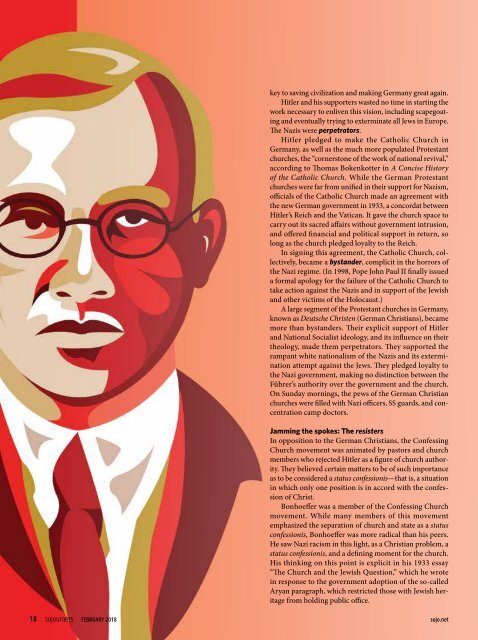february-2018
You also want an ePaper? Increase the reach of your titles
YUMPU automatically turns print PDFs into web optimized ePapers that Google loves.
key to saving civilization and making Germany great again.<br />
Hitler and his supporters wasted no time in starting the<br />
work necessary to enliven this vision, including scapegoating<br />
and eventually trying to exterminate all Jews in Europe.<br />
The Nazis were perpetrators.<br />
Hitler pledged to make the Catholic Church in<br />
Germany, as well as the much more populated Protestant<br />
churches, the “cornerstone of the work of national revival,”<br />
according to Thomas Bokenkotter in A Concise History<br />
of the Catholic Church. While the German Protestant<br />
churches were far from unified in their support for Nazism,<br />
officials of the Catholic Church made an agreement with<br />
the new German government in 1933, a concordat between<br />
Hitler’s Reich and the Vatican. It gave the church space to<br />
carry out its sacred affairs without government intrusion,<br />
and offered financial and political support in return, so<br />
long as the church pledged loyalty to the Reich.<br />
In signing this agreement, the Catholic Church, collectively,<br />
became a bystander, complicit in the horrors of<br />
the Nazi regime. (In 1998, Pope John Paul II finally issued<br />
a formal apology for the failure of the Catholic Church to<br />
take action against the Nazis and in support of the Jewish<br />
and other victims of the Holocaust.)<br />
A large segment of the Protestant churches in Germany,<br />
known as Deutsche Christen (German Christians), became<br />
more than bystanders. Their explicit support of Hitler<br />
and National Socialist ideology, and its influence on their<br />
theology, made them perpetrators. They supported the<br />
rampant white nationalism of the Nazis and its extermination<br />
attempt against the Jews. They pledged loyalty to<br />
the Nazi government, making no distinction between the<br />
Führer’s authority over the government and the church.<br />
On Sunday mornings, the pews of the German Christian<br />
churches were filled with Nazi officers, SS guards, and concentration<br />
camp doctors.<br />
Jamming the spokes: The resisters<br />
In opposition to the German Christians, the Confessing<br />
Church movement was animated by pastors and church<br />
members who rejected Hitler as a figure of church authority.<br />
They believed certain matters to be of such importance<br />
as to be considered a status confessionis—that is, a situation<br />
in which only one position is in accord with the confession<br />
of Christ.<br />
Bonhoeffer was a member of the Confessing Church<br />
movement. While many members of this movement<br />
emphasized the separation of church and state as a status<br />
confessionis, Bonhoeffer was more radical than his peers.<br />
He saw Nazi racism in this light, as a Christian problem, a<br />
status confessionis, and a defining moment for the church.<br />
His thinking on this point is explicit in his 1933 essay<br />
“The Church and the Jewish Question,” which he wrote<br />
in response to the government adoption of the so-called<br />
Aryan paragraph, which restricted those with Jewish heritage<br />
from holding public office.<br />
18 sojourners FEBRUARY <strong>2018</strong><br />
sojo.net


